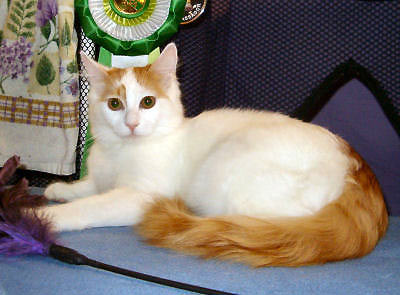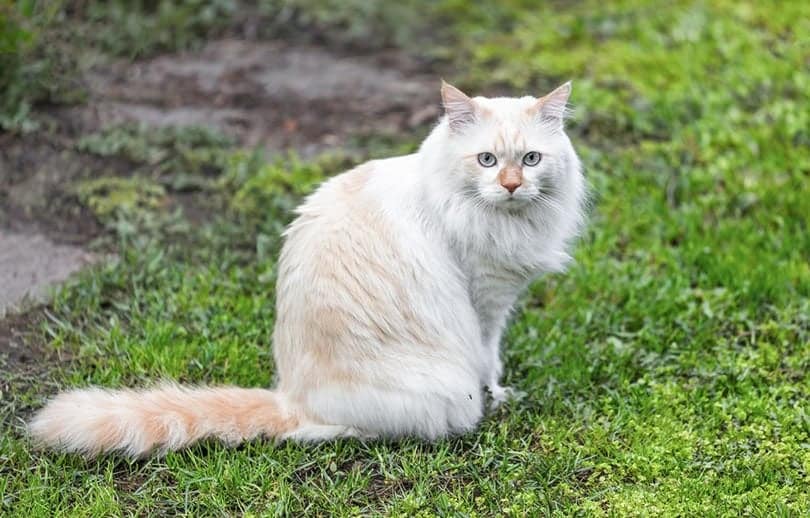
The Turkish Van Cat is one of the oldest natural breed cats, and steeped in a romantic history!
The Turkish Van has a very long, colorful and romantic history. This beautiful cat breed is depicted in the middle ages, from insignia on Roman shields to their likeness found even earlier stamped on Hittite coins. Ancient spiritual stories take them back further still, residing on Noah’s Ark and marked by Allah with the auburn coloring on their heads.
Despite its recognition and popularity today, the Van Cat is a very ancient breed. It is named for Lake Van located in the country of Turkey. So named because it was in this region where they were more recently discovered. In 1955 two British photographers, Sonia Halliday and Laura Lushington, acquired two kittens while visiting the region and returned with them to Britain. Cat fanciers began to take notice and in 1969 the Turkish Van Cats became fully recognized in Britain where it is known as the Turkish Cat.
The Turkish Van is known for its unique coloration. It’s a classic, a chalk white cat but with color primarily on the head and tail, sometimes called “van patterned”. It is also one of the few long-haired breeds that requires little grooming. The Van Cat is a distant cousin to the Turkish Angora. but which originated as an all white cat.
This is a very social breed with a friendly, lively disposition and develops a great fondness for its owners. They are very playful and tend to “teach” the owners. Many know how to play fetch and will drop toys at your feet until you join the game.This is also one of the very few cat breeds that will gladly accompany its owner in the water. The breed exhibits a natural affinity for water and is often dubbed the Turkish Swimming Cat. The Turkish Van is an excellent family cat.
For information about keeping a pet cat, see:
Cat Care: How to Take Care of a Cat
- Kingdom: Animalia
- Phylum: Chordata
- Class: Mammalia
- Order: Carnivora
- Family: Felidae
- Genus: Felis
- Species: domesticus
Common Name(s)
Background
Turkish Vans are one of the oldest natural breeds. They come from the Lake Van Region of southeastern Turkey, previously known as eastern Anatolia. Roman shields have been found in Turkey with the image of Vans on them. Even earlier, some Hittite coins were stamped with the likeness of these cats.
This breed’s ancient roots give way to an interesting legend that suggests a more spiritual history. A Turkish folktale states that the Turkish Van was one of the many animals housed in Noah’s Ark. When the ark landed on Mount Ararat, and the waters receded, the cats exited the ark and made their way down the mountain to the city of Van. The legend claims that the auburn patch of hair on the Turkish Van’s head is a result of being blessed by Allah as they left the Ark.
Though the Turkish Vans have been well known pets in the Van region in Turkey for many centuries, they were discovered by Western cat enthusiasts only recently in 1955. Two kittens, Van Attala and Van Güzelli Iskendrün, were first acquired by two British photographers, Laura Lushington and Sonia Halliday while they were visiting the Van region. They were taken back to Britain, and the process of making them officially recognized by cat fanciers began. This process took 14 years, and they were finally recognized in Britain in 1969.
This breed did not arrive in America until 1982, and was not officially registered until 1985. Common names for this natural breed cat include Turkish Van Cat, Van Cat, Turkish Cat, Turkish Swimming Cat, and Van Kedi.
Description
The Turkish Vans are a semi-long haired cat with a water repellant coat. The coat has a cashmere texture and is described as wash and wear. This breed has no undercoat, which gives it a sleek appearance. The head is a broad wedge shape with a medium-length nose. The eyes are moderately large and rounded. The ears are also moderately large and slightly rounded. The legs are moderately long with the hind legs being longer than the forelegs. The tail is long. They are a medium to large sized cat, females tend to be 9-12 lbs and males tend to be between 14-18 lbs. The lifespan of this breed is 9 to15 years.
They are chalk white with color on their head and tail, and some are solid white. They have many colorations with white such as red, black, blue, cream and brown tabby. The females can also be black tortie/torbie or blue tortie/torbie. In Western shows, it is preferred to have a cat with auburn markings on the head. They can have amber, blue or odd-eyes (one amber and one blue). In Turkey, the all-white (or Van Kedi), odd-eyed or blue eyed cat is the preferred color type.
Care and Feeding
The Turkish Van requires no special diet.
Housing Your Cat
This breed enjoys the outdoors, especially areas with water, but is also able to adapt to apartment life. Indoors it should be provided with toys and a scratching post indoors.
Maintenance
Unlike many long-haired breeds, the Turkish Van requires only a weekly brushing.
Social Behaviors
Previous lines of this breed have been known to be aggressive, but those characteristics have been selectively eliminated, leaving an affectionate, friendly breed, especially toward other cats. They are very social and make an excellent family cat as well.
Activities
Turkish Vans are moderately playful, active, and love swimming. They like interactive games with their owners. Many will want to play fetch, dropping toys at their owner’s feet to encourage play. On of the incredible attributes of the Turkish Van Cat is that they enjoy water, and will happily join their owner in the swimming pool. With their natural affinity for water they are often referred to as the Turkish Swimming Cat.
Breeding/Reproduction
Average litter size is 4 or 5 kittens.
Common Health Problems
They are a naturally healthy breed with no known breed specific health problems.
Availability
This is a rare breed, but breeders can be located on the internet. For a pet kitten be prepared to spend between $500.00 and $650.00 for one of these treasured cats to join your household.
References
- See Animal-World References: Cat Breeds – Exotic Cats
- Turkish Van Information, The Turkish Van Site
Featured Image Credit: Vadim Petrakov, Shutterstock
